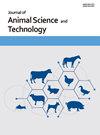提高饲粮赖氨酸和能量水平对生长肥育猪生长效率、养分吸收和胴体性状的影响
IF 3.2
3区 农林科学
Q1 AGRICULTURE, DAIRY & ANIMAL SCIENCE
引用次数: 0
摘要
本研究旨在评估提高饲粮标准回肠可消化赖氨酸和净能水平对生长育肥猪生长、营养吸收和胴体性状的影响。试验选用90头[(约克郡×长白)×杜洛克]猪,随机分为3个处理(6个重复/处理),每栏5头猪(3头母猪和2头后备母猪),平均初生体重为20.51±0.02 kg。试验期16周(生长期,初至第8周;育成期(第8 ~ 16周)。生长和肥育阶段的饲粮处理分别为对照(CON)、TRT1(基础饲粮+ 0.05% SID赖氨酸)和TRT2(基础饲粮+ 0.05% SID赖氨酸+ 0.084 MJ/kg净能)。TRT1组和TRT2组的饮食均有改善(<italic>p</italic>与CON组相比,12周平均日增重(<italic>p </italic>= 0.088)和全期平均日增重均有提高的趋势(<italic> = 0.088)。此外,TRT2组猪的背膘厚度更高(<italic>p</italic>= 0.034),与TRT1和CON饮食相比。然而,没有发现任何治疗效果(<italic>p</italic>和gt;0.05)的营养吸收和胴体等级差异。因此,在生长和肥育期饲粮中添加0.05% SID赖氨酸和0.084 MJ/kg净能是提高猪生长效率和胴体背膘厚的较好方法。本文章由计算机程序翻译,如有差异,请以英文原文为准。
Effects of increasing dietary lysine and energy levels on growth efficiency, nutrient absorption, and meat carcass traits in growing-finishing pigs
This study was executed to estimate the impacts of increasing dietary standardized ileal digestible (SID) lysine and net energy levels on growth, nutrient absorption, and meat carcass traits in growing-finishing pigs. In total, 90 pigs [(Yorkshire × Landrace) × Duroc] were erratically dispensed to 3 treatments (6 replicate/treatment) with 5 pigs (3 barrows and 2 gilts) per pen, and their average primary body weight was 20.51± 0.02 kg. The trial period was 16 weeks (growing stage, initial to week 8; finishing stage, week 8 to week 16). The dietary treatments used included control (CON) as the basal diet, TRT1 (basal diet + 0.05% SID lysine), and TRT2 (basal diet + 0.05% SID lysine + 0.084 MJ/kg net energy) for both the growing and finishing stages. Both the TRT1 and TRT2 group diets improved (p = 0.033) average daily gain (ADG) at week 12 and tended to enhance (p = 0.088) body weight at week 12 and ADG at the overall period compared to the CON group. Moreover, pigs in the TRT2 group had higher backfat thickness (p = 0.034) at week 12 in comparison to the TRT1 and CON diets. Nevertheless, no treatment effect was found (p > 0.05) in nutrient absorption or carcass grade among the dietary treatments. Hence, incorporating the increasing level of 0.05% SID lysine and 0.084 MJ/kg net energy into the pig diet during the growing and finishing stages can be considered a suitable approach for enhancing both growth efficiency and carcass backfat thickness in pigs.
求助全文
通过发布文献求助,成功后即可免费获取论文全文。
去求助
来源期刊

Journal of Animal Science and Technology
Agricultural and Biological Sciences-Food Science
CiteScore
4.50
自引率
8.70%
发文量
96
审稿时长
7 weeks
期刊介绍:
Journal of Animal Science and Technology (J. Anim. Sci. Technol. or JAST) is a peer-reviewed, open access journal publishing original research, review articles and notes in all fields of animal science.
Topics covered by the journal include: genetics and breeding, physiology, nutrition of monogastric animals, nutrition of ruminants, animal products (milk, meat, eggs and their by-products) and their processing, grasslands and roughages, livestock environment, animal biotechnology, animal behavior and welfare.
Articles generally report research involving beef cattle, dairy cattle, pigs, companion animals, goats, horses, and sheep. However, studies involving other farm animals, aquatic and wildlife species, and laboratory animal species that address fundamental questions related to livestock and companion animal biology will also be considered for publication.
The Journal of Animal Science and Technology (J. Anim. Technol. or JAST) has been the official journal of The Korean Society of Animal Science and Technology (KSAST) since 2000, formerly known as The Korean Journal of Animal Sciences (launched in 1956).
 求助内容:
求助内容: 应助结果提醒方式:
应助结果提醒方式:


